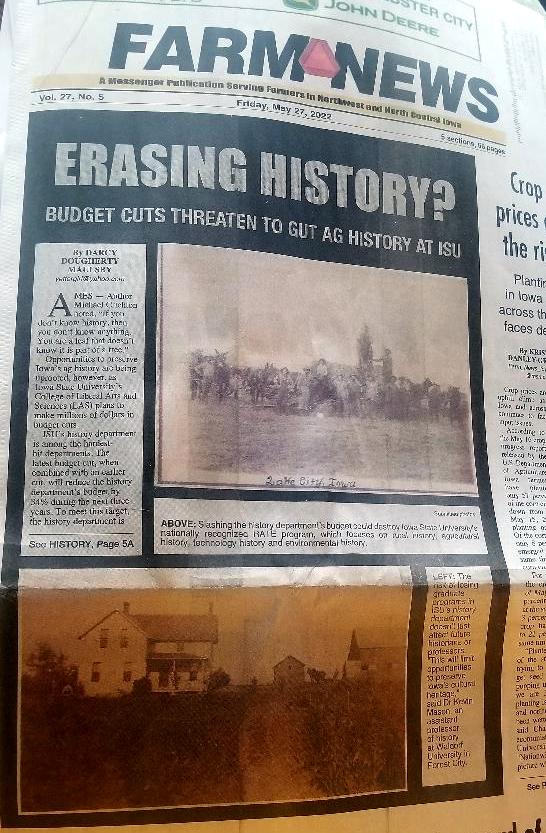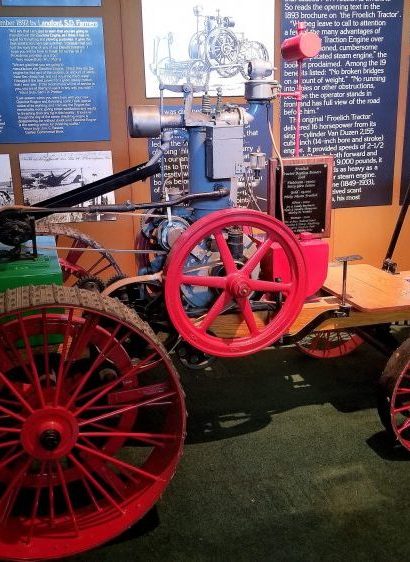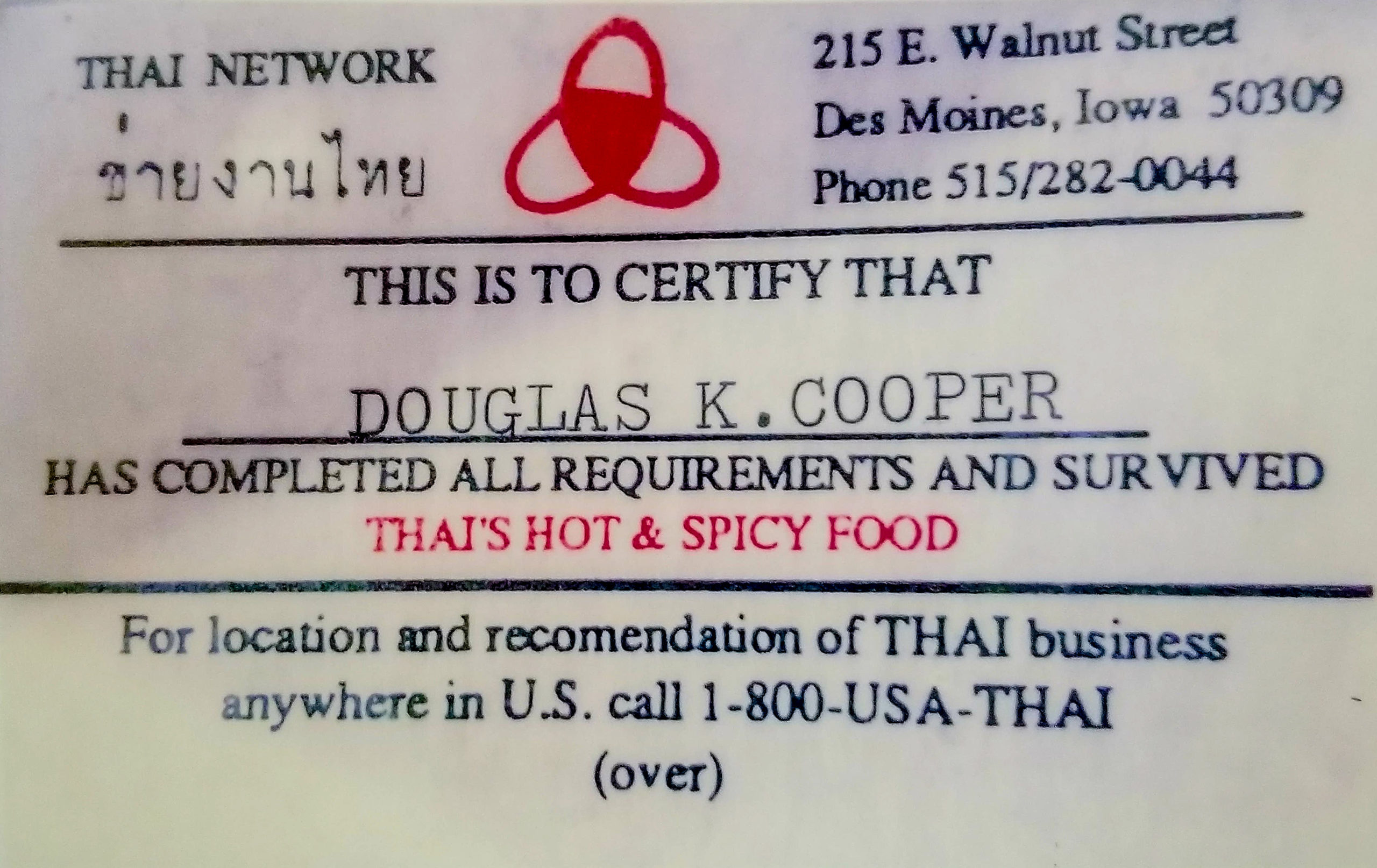
Whats HOT
Latest Posts

Imagine That! Writers, Put Your Reader Right in the Action
“Picture this – you’re boarding a plane headed to an exotic or historic destination, like Rome or Dubai. You settle into your roomy business or first-class seat and the best part is, you didn’t have to pay for any of this. Sound too good to be true? Not if you were a United States Agency for International Development (USAID) employee between at least 2012-2014.”
Bet this hooked you, even if you’ve never heard of the USAID, right?
I knew nothing about the USAID, but I couldn’t resist scanning the e-mail when I read, “Picture this—you’re on a plane….” It put me right in the middle of the story, right from the start, and I wanted to know how the story ends.
That’s how you hook a reader, my friends. Craft your story so the audience sees themselves in it. It’s possible, even with a potentially dry, obscure topic.
Yes, even a press release can stir emotion
Would you be surprised to know this powerful writing example came from a press release issued by a politician from Iowa?
The release went on to detail documents revealing that “USAID employees have been purchasing business or first-class tickets for years, racking up nearly $3.1 million in taxpayer dollars on extravagant plane travel between 2012 and 2014.”
In the hands of less skilled writer, the title or lead of this news release could have been “Senator Questions USAID Deluxe Travel Expenses.” It would have been accurate, but boring. Most readers (myself included) probably have no idea what the USAID is. Game over, because we quit reading and move on. There’s nothing here of interest, right?
Think again.
Like millions of other Americans, I do care about wasteful spending of my tax dollars. I’m glad to know at least some of my elected officials are monitoring potential abuses of the system and are working to find solutions.
I won’t know this, however, if my elected officials aren’t communicating in a way that’s clear and compelling.
Now that I’ve pictured myself on settling in to a first-class seat on a plane bound for an exotic or historic destination—and I didn’t have to pay for any of this—I’m frustrated when I read that “one USAID employee took a $15,000 business-class trip, when the same trip would have only cost $3,000 if the employee had flown coach.”
This feeling of frustration isn’t something that lackluster writing provokes. Words that not only convey truth but stir emotion are a sign of a story well told.
Show, don’t tell
That’s the beauty of the “picture this” storytelling technique. It’s an effective way for authors, marketers and other writers to fulfill the age-old writing advice to “show, don’t tell.”
Sometimes I switch up the words a bit and lead with “Imagine this,” but the goal is still the same. Capture readers’ imaginations. Place them right in the center of the action. Motivate them to keep reading. It’s a powerful tool to that will propel you beyond the ranks of boring writers who fail to hold readers’ attention.
Imagine that!
What do you think?
Have you tried using the “picture this” or “imagine this” lead? Any other good tips for capturing your readers’ attention from the start? I welcome your comments and stories.
Want more?
Thanks for stopping by. I invite you to read more of my blog posts if you want more tips to make you a better communicator, along with intriguing Iowa stories, history and recipes. If you like what you see and want to be notified when I post new stories, be sure to click on the “subscribe to blog updates/newsletter” button at the top of this page. Let’s stay in touch. I’m at darcy@darcymaulsby.com.
P.S. Thanks for joining me. I’m glad you’re here.
@Copyright 2017 Darcy Maulsby & Co.
In the meantime, perhaps you’ll find value in my Top 10 Tips to Find the Right Writer to Tell Your Company’s Stories.
Top 10 Tips to Find the Right Writer to Tell Your Company’s Stories
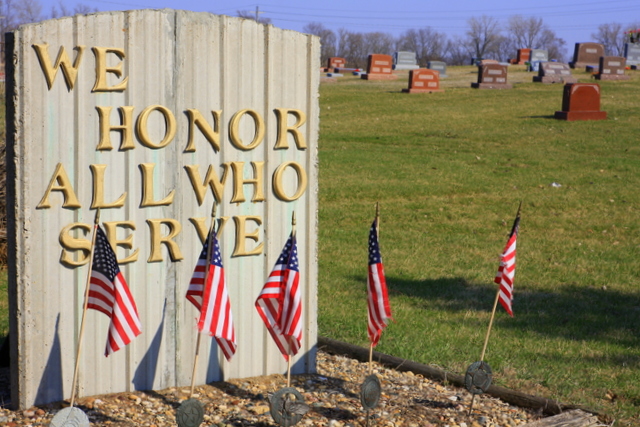
How to Thank Veterans for Their Military Service
It shocked me the first time it happened. I was sitting in the living room of a World War 2 veteran and was interviewing him for a Memorial Day story. I felt humbled and grateful to hear his stories as he described the places he’d served, the hardships he had experienced, his fears and his perspective on life all these years later. What stunned me was his family’s reaction.
“That’s the first time I’ve heard most of those stories,” said his daughter who had stopped by during the interview.
This wouldn’t be the first time I’d have this experience. I’ve discovered that sometimes veterans won’t open up, even to loved ones, because the memories are too painful, but sometimes the reasons are much simpler. “I tried sharing these stories a few times, but my family didn’t really understand what I was talking about and didn’t ask any questions, so I just gave up,” one Iowa veteran told m e. “I decided it would be easier to talk about these things with other veterans.”
e. “I decided it would be easier to talk about these things with other veterans.”
This got me thinking—what’s the right way to talk to veterans, whether you want to thank them or hear more of their stories? If you’re like me, maybe you’re not even sure how to start the conversation.
That’s why I asked Marine Corps veterans James Nash and Jay Lippmeier for their insights. I first connected with Nash and Lippmeier after they came to Lakota, Iowa, for Hunting with Heroes. This amazing program, which was created by Bernie and Jason Becker, invites Marines from the Wounded Warrior Battalion at Camp Lejeune, North Carolina, to the Midwest each November for an all-expenses-paid trip to find some peace in the Iowa countryside and enjoy some prime pheasant hunting.
Captain Nash is now retired from the Marine Corps and lives in Oregon. He enjoys returning to Iowa to help create a sense of camaraderie and comfort for the Marines who participate in Hunting with Heroes for the first time. Staff Sergeant Lippmeier, who participated in the 2016 Hunting with Heroes event, is a Cincinnati, Ohio, native who recently retired from the Marines Corps and appreciates the chance to spend more time with his family, including his children.
I’d like to thank Captain Nash and Staff Sergeant Lippmeier for their friendship and for letting me share their insights in my May 26, 2017, Farm News column, which I’m also sharing here:
Q: Any tips on what people can say to veterans to start the conversation?
Nash: When folks say thanks for your service, it does two things to me. I typically sense their gratitude, but I also sense that sometimes people issue that canned phrase to reassure their sense of patriotism to themselves, and they are not interested in what exactly it is they’re thanking me for.
When I talk to vets, I ask then what branch they were in and what their job was. Army vets often respond with a numerical designation for their military occupational specialty (MOS), like 11B. That’s fine, but ask what that means, where were they stationed, what unit did they serve with? Did they deploy? Do they still keep in touch with anyone they served with?
If these questions don’t begin a conversation, the veteran likely doesn’t want to talk. Respect that. That’s the time to end the conservation and say thank you. It won’t be hollow because, now you both know what you are thanking the veteran for.
Lippmeier: Treat veterans like other people you’ve just met. Ask them what they do/did in the military, like their branch of service and their military occupation. Then use follow-up questions, especially if you don’t understand the answers or certain verbiage the military uses. I would much rather explain something to someone than have them have no clue what I’m talking about.
Upon first meeting someone, most vets I know have no problem talking about what branch they were in or what job they did without going into a lot personal details. Most vets will start to open up a bit as they get more comfortable. If someone doesn’t want to talk about his or her service, respect that. Everyone has bad days sometimes.
Q: Are there any things people shouldn’t ask?
Nash: I don’t like when folks asked me how many people I killed. It’s not like I wrote hash marks in my journal. But if they do ask, that’s better than if they are afraid to ask. When I sense people don’t have the courage to ask about my experiences, it makes me compare that lack of courage to the bravery I witnessed in the men I served with. Then I wonder why we risked so much for that person’s freedom.
I remember that it’s always incumbent upon the brave to protect the fearful, for a few to sacrifice for the many, but it doesn’t feel good when I compare the fear of driving through a minefield, getting shot at by snipers or having mortars explode around me to someone’s fear of simply asking me what that was like.
Lippmeier: The number one question people shouldn’t ask is, “Have you ever killed anyone?” That is by far the question I ‘ve been asked the most, and it’s definitely a loaded question and a very personal one, as well.
Besides that, most vets will let you know if they don’t want to answer a certain question, or they may shut down if a question strikes a nerve. Again, just respect that and move on. I’m sure there are questions that would make anyone uncomfortable, so just use your best judgment and treat vets with the same respect you would treat any person you just met.
Q: Are there any things you wish people knew about the military or veterans?
Nash: Not every service member experiences combat. Most don’t. It’s important to not discount their sacrifice in the time they spend away from their loved ones and the relative hazards to their job. Also, when it comes to injuries, you must understand that paralysis and amputations are dramatic, but many injuries are unseen. A lot of folks look at me and say things like, “Well, it looks like you are doing just fine.” To which I think, yeah, it’s just my brain and spine that were damaged. No big deal. But I don’t say that.
Lippmeier: The biggest thing that I wish people knew is that everyone’s military experience will vary. Just because someone was in the military doesn’t mean they were in combat. The majority of veterans don’t see combat, but just because a vet wasn’t in combat doesn’t make their service less honorable. Without vets that didn’t see combat, the combat guys wouldn’t be able to do their jobs.
Another thing is that not all injuries are visible. You can spot guys who are missing limbs or using wheelchairs or other devices, but the majority of vets who are injured have “invisible wounds.” Just because I have 10 fingers and 10 toes doesn’t mean I don’t have five herniated discs, scar tissue in my brain, severe post-traumatic stress disorder, and a laundry list of other injuries. So just realize there can be a plethora of things going on with someone even though he or she looks ok.
Q: Any other tips for how civilians can communicate better with veterans?
Lippmeier: Treat veterans like normal people, but realize they’ve had a lot of different experiences than non-vets. Just be patient, and veterans will usually open up after some time. It’s sometimes hard for veterans to let someone in their life, because they may have seen or had someone close to them be violently torn from their life.
Nash: Know that if you ask these questions, the answers may make you uncomfortable. Try to compare your discomfort with the experience of the person you are speaking to, and hopefully it will give you the guts the hang in there and have the conversation. Let veterans know their sacrifices were worth the cost.
I salute our veterans
I salute America’s military men and women, including Captain Nash and Staff Sergeant Lippmeier, and am forever grateful to those who trust me enough to share their stories. We must never forget their service and their sacrifices. (Click here to hear Captain Nash, in his own words, talk about everything from hunting to his experiences as an officer to being awarded the Purple Heart.)
Some veterans will tell you that Veterans’ Day is the time to member those who survived, while Memorial Day is to honor those who have died. That’s true, yet Memorial Day to me means a time to honor all our military personnel, including those who have passed away, veterans who are still with us and those serving on active duty.
A respect for all veterans was instilled in me from childhood as my parents took me each May to the Lake City Cemetery for the Memorial Day service. The roll call of the deceased is one of the most poignant parts of the service. As I listen for the name Henry C. Nicholson, an ancestor of mine who fought in the Civil War, I also glance around the crowd and see the veterans who are still with us. These men and women are my friends and neighbors who came back to Iowa to farm, work hard, raise a family and give back to their community. These are the everyday people who make America work.
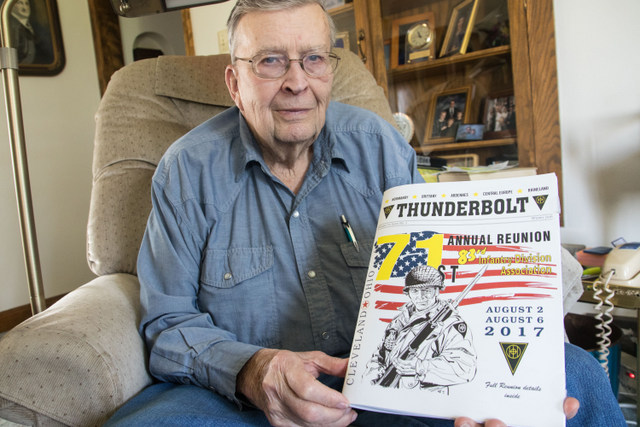
Harold Geisinger, 91, of Storm Lake, Iowa served in Europe in the U.S. Army during World War 2. This retired farmer continues to help on his family’s farm north of Storm Lake.
“Thank God it’s over”
Most of these veterans are humble, unassuming people, like Harold Geisinger of Storm Lake. I was honored to sit down with this World War 2 veteran this May. What started as as interview about his family’s Buena Vista County Century Farm turned into an unforgettable conversation about his service in the U.S. Army in the waning days of World War 2. Here’s a sample of his story, which I originally wrote for Farm News:
While V-E Day (Victory in Europe) was proclaimed “the celebration heard ‘round the world,” it was only a temporary reprieve for Harold Geisinger. This 19-year-old Iowa farm boy from Storm Lake was on his way to Le Havre, France, with the U.S. Army when Germany surrendered unconditionally to the Allies on May 7, 1945.
After a low-key celebration, Geisinger and his fellow soldiers boarded a box car in France bound for Hanover, Germany. Geisinger then joined a convoy in Bavaria, the section of Germany where American troops were guarding railroads, train depots, irrigation sites and more.
While the war was over in Europe, fighting continued on the other side of the globe. In the summer of 1945, there was talk that Geisinger and his fellow soldiers would likely be on board the next U.S. military ship bound for the Pacific Theater. Everything changed, however, when Japan surrendered on Sept. 2, 1945, following President Harry S. Truman’s orders to drop two atomic bombs on Japan in August 1945.
“When we got the word that Japan quit, we didn’t celebrate,” said Geisinger, 91, who still gets tears in his eyes when he thinks back to those days nearly 72 years ago. “We simply sat down and said, ‘Thank God it’s over.’”
Read off of Harold’s remarkable story here.
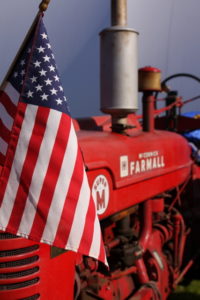 Want more?
Want more?
Thanks for stopping by and listening to these stories. I invite you to read more of my blog posts if you want more Iowa stories, history and recipes, as well as tips to make you a better communicator. If you like what you see and want to be notified when I post new stories, be sure to click on the “subscribe to blog updates/newsletter” button at the top of this page. Let’s stay in touch.
P.S. Thanks for joining me. I’m glad you’re here.
@Copyright 2017 Darcy Maulsby & Co.

“Thank God It’s Over:” Iowa Veteran Recalls the Final Days of World War 2
While V-E Day (Victory in Europe) was proclaimed “the celebration heard ‘round the world,” it was only a temporary reprieve for Harold Geisinger. This 19-year-old Iowa farm boy from Storm Lake was on his way to Le Havre, France, with the U.S. Army when Germany surrendered unconditionally to the Allies on May 7, 1945.
After a low-key celebration, Geisinger and his fellow soldiers boarded a box car in France bound for Hanover, Germany. Geisinger then joined a convoy in Bavaria, the section of Germany where American troops were guarding railroads, train depots, irrigation sites and more.
While the war was over in Europe, fighting continued on the other side of the globe. In the summer of 1945, there was talk that Geisinger and his fellow soldiers would likely be on board the next U.S. military ship bound for the Pacific Theater. Everything changed, however, when Japan surrendered on Sept. 2, 1945, following President Harry S. Truman’s orders to drop two atomic bombs on Japan in August 1945.
“When we got the word that Japan quit, we didn’t celebrate,” said Geisinger, 91, who still gets tears in his eyes when he thinks back to those days nearly 72 years ago. “We simply sat down and said, ‘Thank God it’s over.’”
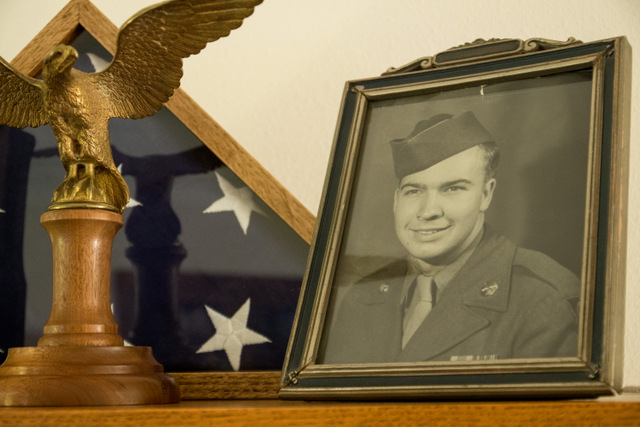
After graduating from Storm Lake High School in 1944, Harold Geisinger was drafted into the U.S. Army on Aug. 2, 1944. “Back then, we all wanted to serve,” he said.
Battle of the Bulge put Geisinger on the fast track
As a World War 2 veteran, Geisinger is becoming a rare breed. Only 620,000 of the 16 million Americans who served in World War II were alive in 2016, according to U.S. Department of Veterans Affairs statistics.
Like many members of the Greatest Generation, Geisinger’s life would never be the same after Japan attacked Pearl Harbor on December 7, 1941. “I was walking up the steps of our house and the radio was on,” said Geisinger, who stills lives in this house on the north edge of Storm Lake. “That’s when I heard the news about Pearl Harbor.”
After graduating from Storm Lake High School in 1944, Geisinger was drafted into the U.S. Army on Aug. 2, 1944. “Back then, we all wanted to serve,” he said.
Following 17 weeks of basic training in Arkansas, things moved quickly for Geisinger. “As my basic training was ending, the Battle of the Bulge was beginning, so the Army fast tracked us,” said Geisinger, who left on Christmas Day 1944 for Camp Myles Standish in Massachusetts. This U.S. Army camp functioned as a departure area for thousands of U.S. soldiers during World War 2.
In mid-December 1944, Germany had launched its last major offensive and intended to split the Allied armies. This surprise blitzkrieg in northwest Europe, which became known as the Battle of the Bulge, did not turn the tide of the war in Adolph Hitler’s favor but did result in American and civilian casualties.
The Battle of the Bulge was still raging when Geisinger shipped out for Europe on January 2, 1945. “I was on my two-week ‘ocean cruise,’” said Geisinger, who had turned 19 just a few days earlier on Christmas Eve.
When Geisinger and his fellow soldiers with the Army’s 83rd Infantry Division, Company I, arrived at Le Havre, France, they were transferred to railroad box cars bound for Givet, a small community in the north of France, near the Belgian border. “These box cars were called ’40 by 8s,’ meaning they could hold 40 men or 8 horses,” said Geisinger, who recalled that it was close to a month after he left America before he had the chance to take a real shower—not just a saltwater shower on the ship.

The Battle of the Bulge was still raging when Harold Geisinger shipped out for Europe on January 2, 1945. Geisinger and his division spent most of their time training in the Hürtgen Forest, located along the border between Belgium and Germany. “Our division was preparing to push across Germany,” Geisinger said.
Much worse than the shower situation, however, were the frigid January temperatures and lack of adequate overshoes during the box car ride. “I froze my feet,” Geisinger recalled.
After reaching their destination, Geisinger and his division spent most of their time training in the Hürtgen Forest, located along the border between Belgium and Germany. “Our division was preparing to push across Germany,” Geisinger said.
In the meantime, however, Geisinger was waging his own battle with a cough that wouldn’t go away. The coughing became severe that he couldn’t eat. On Feb. 14, 1945, he had to go on sick call and was diagnosed with viral pneumonia. Geisinger returned to France and was transferred to a hospital in southern England at Newton Abbot. “I was there two months with no medicine,” said Geisinger, who eventually recovered and returned to active duty.
In early May 1945, Geisinger was crossing the English Channel in a ship bound for Le Havre, France, when he heard the news that Germany had surrendered. Although Hitler and the Nazis had been defeated, Geisinger knew he wouldn’t be returning home to northwest Iowa anytime soon. After boarding another box car, Geisinger headed to Bavaria to rejoin Company I and the men he had served with before.
Everyone wondered if they’d be called to fight the war in Japan. “Had we shipped out, some said we would have left from Marseille in southern France and sailed around Cape Horn and onto Japan,” Geisinger said. “When I heard that Japan surrendered, I kept thinking, ‘Someday we’ll get to go home.’”
Transitioning from solider to farmer
That day wouldn’t come for months, however. Geisinger remained in Europe and remembers pulling guard duty along the Danube River. He crossed the river with a buddy one night to meet Russian soldiers on the other side.
“We drank a little beer with a Russian sergeant and tried to communicate using hand signals and the little bit of German we and the Russian had picked up,” Geisinger said. “The one thing the Russian sergeant wanted was American uniforms. He wanted all the American uniforms he could get.”
Geisinger couldn’t access any uniforms other than the one he was wearing. He had no idea why the sergeant wanted American uniforms, although he later suspected an ulterior motive. “I assumed it was for infiltration,” said Geisinger, whose distrust of the Russian sergeant proved accurate as the Cold War heated up.

As he sits in his home office, Harold Geisinger looks through pieces of the past, including World War 2 history books.
By the time Geisinger was honorably discharged from the Army, he had achieved the rank of corporal. He looked forward to returning to Storm Lake to farm and finally reached home in July 1946. By then, agriculture had entered a new era as the transition to mechanical horsepower from traditional horsepower became complete. New equipment like combines also became more common in row-crop production.
Geisinger started farming with his father, L.J. Geisinger, on the Washington Township farm north of Storm Lake that had been in their family since 1915. Geisinger also used the G.I. Bill to earn his pilot’s license and enjoyed flying for many years.
Geisinger and his wife, Laura May, a Storm Lake High School classmate, raised their three children on the farm, along with corn, soybeans, hay, cattle and hogs. Farming still interests Geisinger, who helps run the field cultivator in the spring and helps combine in the fall. “I even planted some beans this spring,” said Geisinger, who is proud of the rich heritage of his family’s Century Farm in Buena Vista County.
For decades, Geisinger served as a rifleman in the color guard unit in Alta (VFW Post 6172). While he has retired from these duties, his memories of World War 2 remain vivid, and he’s proud he was able to serve his country.
“My military experiences gave me more of global view of the world,” Geisinger said. “Even though a lot has changed since World War 2 and America has its deficiencies, I don’t know of a better place to call home.”
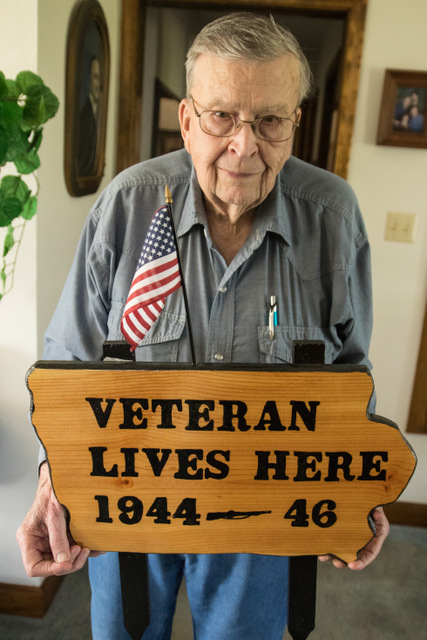
Harold Geisinger’s memories of World War 2 remain vivid, and he’s proud he was able to serve his country.
It was truly an honor to meet Harold Geisinger in May 2017 and interview him at his home and at his family’s farm north of Storm Lake, Iowa. He is a living legacy of America’s Greatest Generation. I’m forever grateful that Harold and hundreds of thousands of others like him were willing to serve. I’m also thankful he was willing to share his stories with me so I can share them with you. (I originally wrote this article for the Memorial Day 2017 of Farm News.)
Want more Iowa culture and history?
I invite you to read more of my blog posts if you want more Iowa stories, history and recipes, as well as tips to make you a better communicator. If you like what you see and want to be notified when I post new stories, be sure to click on the “subscribe to blog updates/newsletter” button at the top of this page. Let’s stay in touch.
Also, if you enjoyed Harold’s military story, be sure to check out my Memorial Day 2017 post on “How to Thank Veterans for Their Service.” I interviewed two recently-retired U.S. Marines from the Wounded Warrior Battalion, and their insights are invaluable.
If you’re hungry for more stories of Iowa history, check out my top-selling “Culinary History of Iowa: Sweet Corn, Pork Tenderloins, Maid-Rites and More” book from The History Press, as well as my Calhoun County” book from Arcadia Publishing, which showcases the history of small-town and rural Iowa. Order your signed copies today! Iowa postcards are available in my online store, too.
P.S. Thanks for joining me. I’m glad you’re here.
@Copyright 2017 Darcy Maulsby & Co.
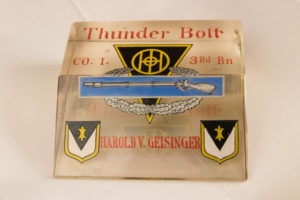
Harold Geisinger served with the U.S. Army’s 83rd Infantry Division, Company I,

Get Your Grill On: How to Build a Better Burger
Love the thrill of the grill? I sure do, especially when I’m crafting a thick, juicy burger I can sink my teeth into. While we talk a lot about burgers during May Beef Month, how much do you really know about this American icon?
The classic hamburger we know and love today is very much an American invention. Stemming from German culinary roots, the burger-on-a-bun phenomenon gained widespread fame at the 1904 St. Louis World’s Fair.
Disaster struck two years later, however, when Upton Sinclair’s novel “The Jungle” (remember the book’s lurid details from high school literature class?) detailed the unsavory side of the American meatpacking industry. Ground beef became a prime suspect, since it could easily be adulterated with questionable additives.
The hamburger might have faded away as a long-forgotten fad were it not for Edgar Ingram and Walter Anderson. When they opened their first White Castle restaurant in Kansas in 1921, White Castle countered the hamburger’s unsavory reputation by becoming bastions of cleanliness, health and hygiene. This paved the way for national hamburger chains founded in the post-World War II boom years, including McDonald’s.
Best burgers, Iowa style
Iowa has made its own distinctive contributions to America’s burger history. Consider the wildly popular Iowa’s Best Burger contest, sponsored by the Iowa Cattlemen’s Association (ICA) and the Iowa Beef Industry Council (IBIC). Iowans submitted more than 9,200 nominations for this year’s contest. Nearly 500 Iowa restaurants were represented in 2017 in the total nominations, setting a new record for the contest.
As a former judge of Iowa’s Best Burger contest, I can tell you how tough it is to pick a winner. Iowans know how to make bodacious burgers, a story I made sure to include in my “Culinary History of Iowa” book.
Size matters when it comes to the Gunderburger at the Irish Shanti, which made the 2017 Top 10 list. The famous Gunderburger started in the late 1970s to put the tiny northeast Iowa community of Gunder on the map. The first Gunderburgers were a smaller version of the one served today. As the Gunderburger started growing in size in the 1990s, its notoriety also grew.
Another 2017 Top 10 Best Burger in Iowa contender is the Ankeny Diner, which offers Maytag Burgers, featuring Iowa’s famous Maytag blue cheese, sautéed onion and Monterey jack cheese. Don’t care for blue cheese? Maybe you’d prefer the Rarebit Burger, served open-faced and topped with spicy Cheddar cheese sauce.
Rarebits were legendary at the iconic Younkers Tea Room in downtown Des Moines for decades. An Iowa-style rarebit burger elevates the traditional Welsh rarebit, which incorporates leftover bits of cheese and the end-of-the-loaf slices of stale bread for a quick supper.
Speaking of Des Moines, the historic East Village is the home of the incomparable Zombie Burger. A previous Top 10 Best Burger in Iowa contender, Zombie Burger serves “gore-met” creations made from the shop’s own custom three-cut beef burger blend. With locations in downtown Des Moines, Ankeny, West Des Moines and the Iowa City area, Zombie Burger is distinguished by classics from the Undead Elvis (a burger paired with peanut butter, fried bananas, bacon, American cheese and mayo) to the Walking Ched (a burger featuring bacon, Cheddar cheese, caramelized onions and mayo on a deep-fried macaroni-and-cheese bun).
Hungry yet?
If all this inspiration has you craving top-quality, Iowa beef, here are my top tips to make your best burgers ever:
• Choose fresh 80/20 ground beef, which provides enough fat to keep your burgers juicy and flavorful.
• Worcestershire sauce adds a whole new depth of flavor to burgers. Add in a healthy dollop and mix it into the meat before forming the patties.
• Use your thumb to create a dimple or well in the center of each patty on the bottom. This helps ensure that the burgers cook evenly. Don’t worry—the indentation will hardly be noticeable by the time the burgers are ready.
• Cook your burgers over medium heat.
• As the patties cook, sprinkle them liberally on both sides with a mixture of salt, fresh-ground pepper, Lawry’s seasoning salt, garlic powder and onion powder.
• Avoid using your spatula to press down on your burgers while cooking. Don’t let all those flavorful juices escape.
• Allow your burgers to rest for a few minutes before serving. This will ensure that the juices redistribute into the meat. Enjoy!
Have any favorite burger recipes or cooking tips? I’d love to hear them. Now go get your grill on!
Hungry for more?
Want more burger inspiration? Check out my blog post on the Lake City Drive-In, where owner Larry Irwin is not only a beef booster, but someone who sees burgers as the perfect palette for culinary creativity with his Burger of the Month flavors. (Don’t miss my recipe for Meatloaf Burgers!)
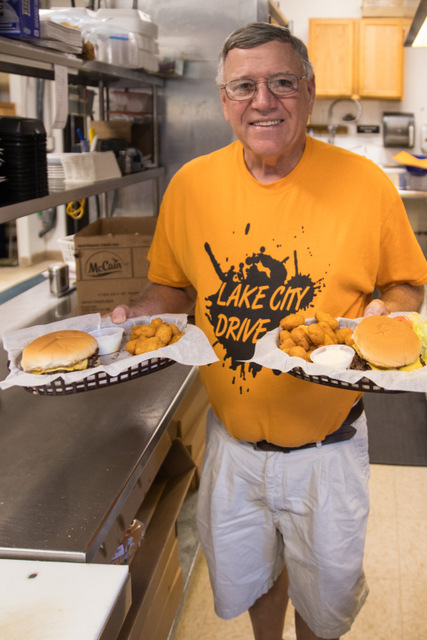
Larry Irwin shows off some tasty burgers from the Lake City Drive-In.
If you’re hungry for more stories of Iowa history, Larry is kind enough to carry my books at the Lake City Drive-In. Not close to Lake City? I invite you to visit my online store, where you can purchase my top-selling “Culinary History of Iowa: Sweet Corn, Pork Tenderloins, Maid-Rites and More” book from The History Press, as well as my “Calhoun County” book from Arcadia Publishing, which showcases the history of small-town and rural Iowa. Order your signed copies today! Iowa postcards are available in my online store, too.
One more thing–check out more of my blog posts if you want more Iowa stories, history and recipes, as well as tips to make you a better communicator. If you like what you see and want to be notified when I post new stories, be sure to click on the “subscribe to blog updates/newsletter” button at the top of this page. Let’s stay in touch!
This originally appeared as one of my weekly columns in Farm News.
P.S. Thanks for joining me. I’m glad you’re here.
@Copyright 2017 Darcy Maulsby & Co.
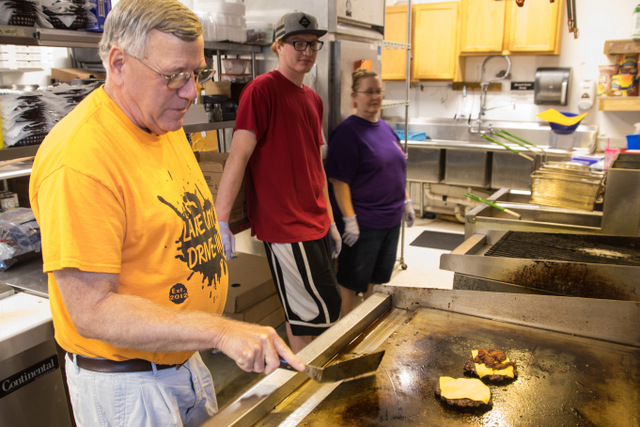
Iowa Beef Booster: Larry Irwin Takes a New Twist on Burgers
Make no mistake, the humble hamburger still reigns supreme from backyard barbecues to fast-food drive-ins across Iowa. But this Iowa icon also provides the perfect palette for culinary creativity when my friend Larry Irwin showcases his Burger of the Month flavors in my hometown of Lake City.
“I’m not doing anything fancy,” said Irwin, who has run the Lake City Drive-In since 2012. “I just like cooking down-home, comfort food.”
While it’s hard to beat a classic bacon cheeseburger, which remains one of the Lake City Drive-In’s top sellers, customers also love the monthly burger specials. Favorites include the Taco Burger (spiced with taco seasoning and chipotle and topped with nacho-cheese flavored chips), Darcy’s Meatloaf Burger, the Swiss Mushroom Burger, and the Ranch Burger (enhanced with homemade ranch dressing, pepper jack cheese and bacon).
“Burgers of all types are always our top sellers,” said Irwin, who serves more than 50 burgers a day, on average. “It’s fun to experiment with new flavors and feature them as the Burger of the Month.”
Top tips for unbeatable burgers
Interestingly, this adventurous spirit in the kitchen isn’t second nature for Irwin, who spent more than 30 years of his career in finance and banking. “I never did much cooking at home,” said Irwin, who grew up on a cattle and grain farm between Lohrville and Rockwell City. “I certainly never thought I’d run a restaurant.”
Irwin has found that offering new men

Larry Irwin shows off some tasty burgers from the Lake City Drive-In.
u items is one of the secrets to keep people coming back to the Lake City Drive-In. Inspiration for the Burger of the Month comes from a variety of sources.
“Sometimes our customers suggest ideas,” Irwin said. “A lot of the Burger of the Month ideas come from my son, Chris, who is an agronomist in northeast Iowa. He travels a lot for his job and tells me about burger flavors he discovers in various cafes.”
While unique flavors are part of the fun, a great burger starts with the basics, said Irwin, who shares the following tips:
• Select an 80/20 ground beef for the best flavor. Irwin always uses fresh beef, never frozen patties, to make his 1/3 pound burgers.
• Preheat the grill before you place the hamburger patties on the grill.
• Cook the hamburger patties over medium heat. If the temperature is too high, it’s easy to burn the outside of the burger and leave the inside undercooked, said Irwin, who cooks his burgers for about five minutes on each side.
• Season the patties on the grill. Irwin sprinkles a mix of garlic powder, onion powder, Lawry’s seasoning salt, table salt, white sugar and black pepper on both sides of each hamburger patty as the meat cooks.
• Don’t forget to butter and toast the bun before serving the burger.
Time-saving systems in the kitchen are also invaluable. Since the Lake City Drive-In is located on Main Street across from South Central Calhoun High School, things can get hectic when hungry crowds stop by, especially during volleyball tournaments and home football games. Irwin plans ahead on these days and cooks each hamburger patty for two minutes per side before placing the partially-cooked patties in a warm slow cooker. When the crowds arrive, it only takes a couple more minutes of grilling time before the burgers are ready.
This strategy also pays off during planting and harvest, when the drive through becomes one of the busiest places at the Lake City Drive-In. “You can always tell when an order is going out to farmers, because there are at least five or six cheeseburgers in there,” said Irwin, who farmed at one point in his career.
Keeping things simple while adding a little variety is the key to a great burger, Irwin added. “I love the flavor of beef. If I could only have one meat for the rest of my life, I’d choose hamburger, because I can make anything out of it.”
Hungry for more? Check out my blog post and Farm News column “Get Your Grill On: How to Build a Better Burger.”

Darcy’s Meatloaf Burger
Darcy’s Meatloaf Burgers
Larry Irwin will be featuring these Meatloaf Burgers, made from my recipe, as the Burger of the Month in June 2017.
2 pounds ground beef
1 1 / 2 to 2 cups herb-seasoned stuffing mix (experiment to find what amount helps the burger patties stick together the best)
1 onion, chopped
1 teaspoon seasoning salt
1/4 teaspoon freshly-ground pepper
1 teaspoon garlic powder
2 large eggs, lightly beaten
1 /4 cup milk
2 tablespoons barbecue sauce
1 / 4 cup ketchup
2 tablespoons brown sugar
1 teaspoon dry mustard
Combine ground beef, stuffing mix, onion, salt, pepper and garlic powder. In a separate bowl, beat eggs, milk, and barbecue sauce. Combine barbecue sauce mixture with meat mixture.
In a separate bowl, combine ketchup, brown sugar and dry mustard. This mixture can either be spread as a glaze while the burgers are cooking on the grill, or the glaze can be mixed into the burger patty mixture before the burgers are grilled.
Shape beef mixture into patties. Grill over medium heat to desired doneness. If using the ketchup mixture as a glaze, spread over the top of each burger during the final minutes of cooking on the grill.
Ranch Dressing
While this makes restaurant-sized quantities, scale down the recipe for home use.
1 gallon regular mayonnaise
1 / 2 gallon buttermilk
2 packages (3.2 ounces each) powdered ranch dressing mix
Combine all ingredients and stir with an electric mixer. Refrigerate.
Boom Boom Sauce
This spicy sauce has a kick and tastes great on burgers and salads.
4 cups Thousand Island dressing
3 / 4 cup buffalo hot sauce
1 / 4 cup red pepper flakes
Combine dressing, buffalo sauce and red pepper flakes; refrigerate.
Sloppy Joes
1 pound hamburger
1 can chicken gumbo soup
Ketchup and mustard, to taste
Brown sugar, to taste
Salt and pepper, to taste
Brown the hamburger; drain. Add soup and season with ketchup, mustard, brown sugar, salt and pepper until the desired flavor is achieved.
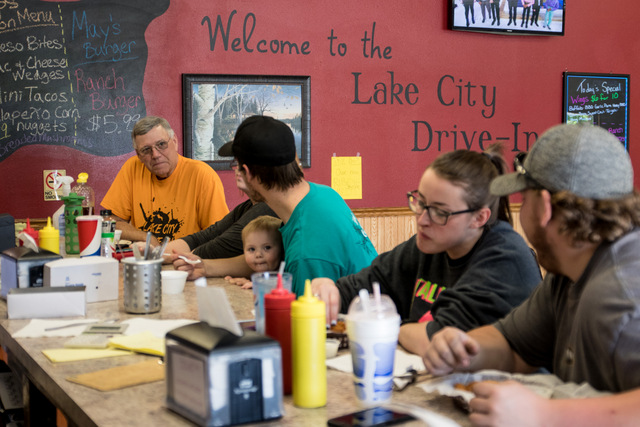
This story first ran on Farm News, May 2017.
Want more Iowa culture and history?
Read more of my blog posts if you want more Iowa stories, history and recipes, as well as tips to make you a better communicator.
If you’re hungry for more stories of Iowa history, Larry is kind enough to carry my books at the Lake City Drive-In. You can also check out my top-selling “Culinary History of Iowa: Sweet Corn, Pork Tenderloins, Maid-Rites and More” book from The History Press, as well as my Calhoun County” book from Arcadia Publishing, which showcases the history of small-town and rural Iowa. Order your signed copies today! Iowa postcards are available in my online store, too.
P.S. Thanks for joining me. I’m glad you’re here.
@Copyright 2017 Darcy Maulsby & Co.
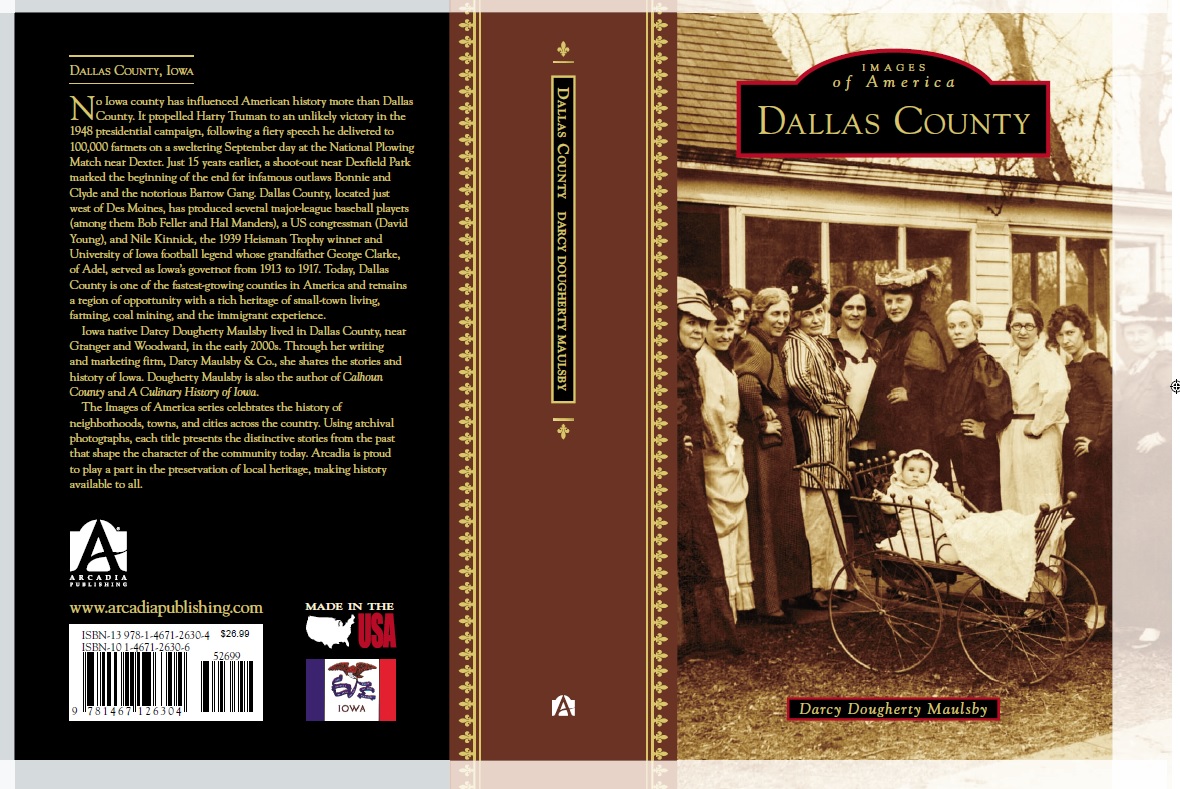
Coming Soon–“Dallas County,” a New Iowa History Book!
No Iowa county has influenced American history more than Dallas County. It propelled Harry Truman to an unlikely victory in the 1948 presidential campaign, following a fiery speech he delivered to 100,000 farmers on a sweltering September day at the National Plowing Match near Dexter. Just 15 years earlier, a shoot-out near Dexfield Park marked the beginning of the end for infamous outlaws Bonnie and Clyde and the notorious Barrow gang.
Dallas County, located just west of Des Moines, is a study in contrasts, from its key role on the Underground Railroad in the 1850s to the revival of the KKK in the 1920s. Dallas County has also produced several Major League Baseball players (including cousins Bob Feller and Hal Manders), a US congressman (David Young), and Nile Kinnick, the 1939 Heisman Trophy winner and University of Iowa football legend whose grandfather, George Clarke of Adel, served as Iowa’s governor from 1913 to 1917.
I’m very excited to announce that “Dallas County,” my third Iowa history book, will be released by Arcadia Publishing on Sept. 4, 2017! This will also be one of the publisher’s first books to be available in a hard cover version for $26.99. Want to know the story behind the cover? These dynamic ladies of the Van Meter Matrons Club (founded in 1909) socialized while improving their knowledge of Iowa heritage and current events. When the group celebrated its 50th anniversary in 1959-1960, historian Hazel Lauterbach said the group “helped me be a better homemaker, citizen, and community member and has taught me the true meaning of teamwork.”
Discover the fascinating stories of Dallas County, which is one of the fastest-growing counties in America and remains a region of opportunity with a rich heritage of small-town living, farming, coal mining, and the immigrant experience.
More details coming soon!
Want more Iowa culture and history?
Read more of my blog posts if you want more Iowa stories, history and recipes, as well as tips to make you a better communicator.
If you’re hungry for more stories of Iowa history, check out my top-selling “Culinary History of Iowa: Sweet Corn, Pork Tenderloins, Maid-Rites and More” book from The History Press, as well as my Calhoun County” book from Arcadia Publishing, which showcases the history of small-town and rural Iowa. Order your signed copies today! Iowa postcards are available in my online store, too.
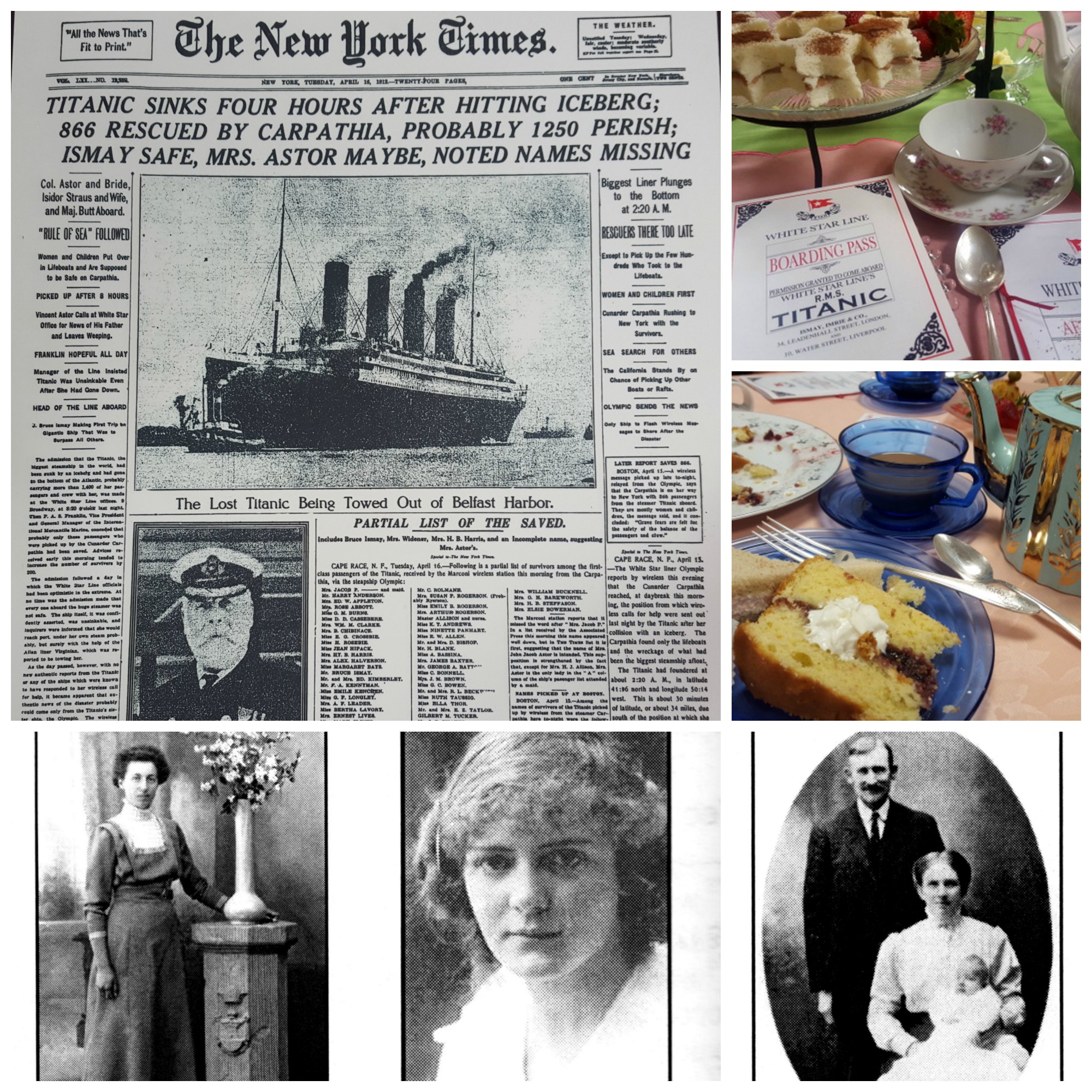
Iowa’s Lost History from the Titanic
I perished on the Titanic, yet I’ve lived to tell the forgotten stories of Iowa’s ties to one of the most famous luxury liners in history. It all started when I attended the Johnson County H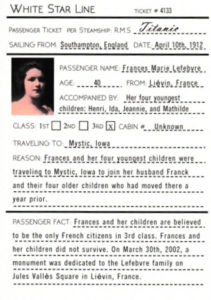 istorical Society’s “Afternoon Tea on the Titanic” in April 2, 2017, and my boarding pass said I was third-class passenger Frances Lefebvre, 40, of Lievin, France.
istorical Society’s “Afternoon Tea on the Titanic” in April 2, 2017, and my boarding pass said I was third-class passenger Frances Lefebvre, 40, of Lievin, France.
As Lefebvre, my four youngest children and I were traveling to Mystic, Iowa, to join my husband, Franck, and our for older children who had moved to Iowa a year prior. I died, along with my four youngest kids, during the sinking of Titanic in the early-morning hours of April 15, 1912.
I was not alone. Of the approximately 2,207 passengers who boarded the Titanic, only an estimated 705 survived. Like Frances Lefebvre, a number of Titanic’s passengers had ties to Iowa. Here are their stories.
Titanic survivor, Orphan Train rider kept low profile in Council Bluffs
One of Titanic’s last living survivors lived in Council Bluffs for decades and rarely spoke of the maritime tragedy or her connection to the Orphan Train Movement.
Helen Delaney’s remarkable story began when she was thrown overboard as Titanic sank. Someone caught the 4-year-old, and she survived the night, although her parents perished. While the family had boarded the ship in England, the names of Delaney’s birth parents are unknown, and Delaney’s didn’t know her exact birth date, according to a 2012 news report in the Council Bluffs Daily Nonpareil.
With the other Titanic survivors, Delaney arrived in New York on April 18, 1912, where she was placed in an orphanage. James P. Delaney, a Council Bluffs locomotive engineer for the Chicago, Burlington & Quincy Rail Company (now BNSF), and his wife adopted the girl after she arrived in Council Bluffs via an orphan train sometime in the mid to late 1910s.
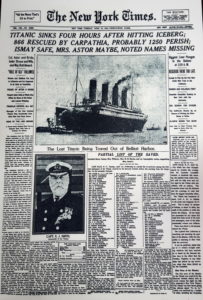 Orphan trains brought thousands of children to Iowa and beyond
Orphan trains brought thousands of children to Iowa and beyond
Children on these orphan trains ranged in age from about six to 18, and they shared a common grim existence. There was little hope of a successful future for these kids if they stayed in the streets, slums and orphanages of New York City.
Their numbers were staggering. An estimated 30,000 children were homeless in New York City as early as the 1850s. The plight of these abandoned, neglected children commanded the attention of a young minister named Charles Loring Brace. He believed that by removing youngsters from the poverty of the city and placing them with Christian farm families, these children could have a chance of escaping a lifetime of suffering.
Brace, who founded the Children’s Aid Society, proposed that these children be sent by train to live and work on farms out west. They would be placed in homes for free but they wouldn’t be indentured.
Children like Helen Delaney boarded westbound trains in groups of up to 40, accompanied by two agents from the Children’s Aid Society. Advertisements appeared in local newspapers along the route in advance of each orphan train’s arrival. When the trains stopped, the children were paraded in front of the crowd and took turns giving their names, singing a song or “saying a piece,” according to “Lost Children: Riders on the Orphan Train,” an article that appeared in HUMANITIES magazine in November/December 2007.
Although the strong demand for the orphans was often motivated by a need for labor, the Children’s Aid Society took pains to ensure the children were well cared for. Families applying to take children had to be endorsed by a committee of local business owners, doctors and other respected community members. Representatives from the society would visit each family once a year to check on conditions, and children were expected to write letters back to the society twice a year, noted the “Lost Children” article.
The Orphan Train Movement, which lasted from 1853 to 1929, placed nearly a quarter of a million children in new homes across the country. This ambitious, unusual social experiment is now recognized as the beginning of the foster care concept in the United States. While some of the children struggled in their newfound surroundings, many others like Helen Delaney went on to lead successful, normal lives as they worked towards the American dream.
Delaney attended school in Council Bluffs, including Mount Loretto Catholic High School. She remained in Council Bluffs, never married and never had children. She lived in anonymity in an apartment at Regal Towers on South Sixth Street, according to the Council Bluffs Nonpareil.
For much of her adult life, Delaney worked as a sales clerk at the Kresge’s five-and-dime store. Only a few people in town knew that this petite, shy, nice clerk had survived Titanic. “She rarely talked about her Titanic legacy,” Dick Warner of the Historical Society of Pottawattamie County told the Council Bluffs Nonpareil in 2012. “Most people who knew her weren’t even aware of it.”
Delaney died on January 26, 1982, at age 74 and was buried at St. Joseph Cemetery off McPherson Avenue in Council Bluffs. She was the only known passenger on Titanic to live in Council Bluffs.
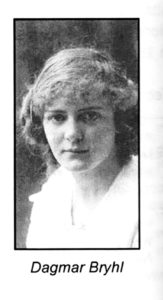
Picture from the book “Not My Time to Die” by Lilly Setterdahl
“Life no longer has any value for me”
Like Delaney, many of Titanic’s survivors and victims were immigrants headed to America to begin a new life. In other cases, the travelers were only planning to visit before returning to Europe. Such was the story of second-class passenger Dagmar Lustig Bryhl, 20, who looked forward to attending a wedding in Red Oak, Iowa, and visiting her uncle Oscar Lustig in Rockford, Illinois, before returning to Sweden.
Author Lilly Setterdahl of East Moline, Illinois, has captured the often heartbreaking—and sometimes heroic—stories of Bryhl and the 122 other Swedes on board Titanic in her fascinating 2012 book, Not My Time to Die. I listened for any tidbits connected to Iowa as Setterdahl related many of these stories during the “Afternoon Tea on the Titanic” in Iowa City.
Consider the letter Bryhl wrote to her uncle while she recuperated in New York following the Titanic disaster (as documented in Not My Time to Die, page 119). Bryhl became so distraught that she wished she had been permitted to die on Titanic with her fiancé, Ingvar Enander, and brother, Kurt.
Dear Uncle,
Titanic has gone down. I don’t know whether my fiancé and my brother Kurt are saved. Evidently, they are not, for most of the men went under. I am at a hospital but am not sick, although very feeble. I have lost everything. I have no clothes, and so cannot get up, so must lie in bed for present.
I would have been glad if I had been permitted to die, because life no longer has any value for me since I lost my beloved. I feel myself so dreadfully alone in this land. These people are certainly good, but nevertheless do not understand me.”
Bryhl asked her uncle to come find her, which he did. Bryhl required bed rest after the long, tiresome journey to Rockford, and she refused to talk to reporters. Her uncle related bits and pieces of her story to local newspapers.
“I was in my berth when the Titanic hit the berg. I noticed the jar and soon I heard Ingvar [her fiancé] knocking on the door of my cabin.“Get up, Dagmar,” he said. “The ship has hit something.” I put on a skirt and coat as quickly as possible and hurried up to the deck. But the officers said, “Go back, there is no danger, you go to your cabins.”
Bryhl returned to her berth and went back to bed. Soon there was more knocking on her door.
“Get up, Dagmar, we are in danger!” Ingvar yelled. “I don’t care what the ship’s officers say. The boat is sinking.”
After pulling on her skirt and coat and running from her berth, Bryhl heard awful screaming and yelling. Women and children were being loaded into lifeboats. Men and women were kissing each other farewell. Ingvar and Kurt led Bryhl to a lifeboat, and Ingvar lifted his fiancé into the boat. She seized his hands and wouldn’t let go. “Come with me!” Bryhl screamed as loud as she could, still holding Ingvar’s hands tight. There was room in the lifeboat, which was only half full. Suddenly an officer ran forward and clubbed back Ingvar.
“This officer tore our hands apart, and the lifeboat was let down. As it went down, I looked up. There, leaning over the rail stood Kurt and Ingvar side by side. I screamed to them again, but it was no use. They waved their hands and smiled. That was the last glimpse I had of them.”
As the men in the lifeboat rowed the boat away from Titanic, the passengers shivered in the frigid night air as they watched the great ship sink.
“Then more dreadful screams,” said Bryhl, who recalled that the sea was so still it was clear as a mirror beneath the cloudless sky. “The water filled with crying people. Some of them climbed in our boat and so saved their lives.”
The small group of survivors huddled in the lifeboat until 6 a.m. on Monday, April 15, when the Carpathia arrived. Hours in the freezing air without adequate clothing to protect against the stinging cold numbed Bryhl’s body.
According to her uncle, Bryhl declared repeatedly between hysterical sobs that she never would have allowed her brother and fiancé to put her in the lifeboat if she thought the two men would be lost. She said she would rather have died with them when the great ship settled into the depths than to live with the memory of all that took place.
Bryhl returned home to Sweden in May 1912 after only a short time in Rockford. She later married a teacher named Eric Holmberg. She died in August 1969, Setterdahl noted.
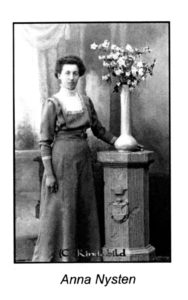 “Not my time to die”
“Not my time to die”
During “Afternoon Tea on the Titanic,” Setterdahl (a native Swede herself) also detailed the life of 22-year-old Anna Nysten, the woman whose story provided the title for Setterdahl’s book.
Nysten had planned to leave Sweden in the summer of 1912 to visit her sister Klara in Passaic, New Jersey. However, some of Nysten’s friends who were headed to America that spring persuaded her to go with them. Nysten traveled with the Andersson family from Kisa, Sweden, and the Danbom family from Stanton, Iowa. Nysten would be the lone survivor of the 11-member group.
“I can hardly describe how it happened,” Nysten wrote to her parents in the wake of the Titanic disaster. “There was terrible screaming and groaning, but you and I ought to thank God that I am alive. I managed to get into a lifeboat because I don’t think it was my time to die. I’m supposed to experience more of the world.”
Nysten offered more details of the disaster after Titanic struck the iceberg (as documented in Not My Time to Die, pages 167-169).
“There was a terrible jolt, so we nearly fell out of bed. But then they said it was not serious, so the passengers calmed down until the ship began to sink and the deck was full of people.”
After someone took Nysten’s lifebelt and she began crying, a sailor gave her his life jacket. While her traveling companions proclaimed they would all go down together with the ship, a sailor pushed Nysten into a lifeboat.
“Oh, how terrible it was when everything went dark,” said Nysten, who recalled that her lifeboat could have held 63 people but only had about 40 passengers when it was lowered into the sea. “When the ship went down we were not far away and were almost sucked under.”
Nysten and the others in the lifeboat heard an awful rumbling noise as the great ship sank. They sat in the lifeboat from 1:30 a.m. to 6:30 a.m., but “fortunately the sea was calm,” she recalled.
“You can imagine how happy we were to see the steamer Carpathia close in on us and we could come aboard. They were so good to us.”
The survivors were given blankets, coffee and brandy (“as much as we wanted,” Nysten noted).
“But there was still much groaning and crying because most of us had lost a dear relative,” Nysten recalled. “Many became hysterical.”
In New York, Nysten was taken to the Swedish Immigrant Home, where she received $25 from the Women’s Relief Committee. Nysten spent three years in New York with friends and intended to return to Sweden, but when the Lusitania was torpedoed in 1915, she changed her mind. She came to Boone, Iowa, and moved to Des Moines in 1916, where she married Arvid Gustafson in 1917. The couple had three sons and were members of the First Lutheran Church in Des Moines.
Nysten was one of the few Titanic survivors who married, had children and was not reluctant to talk about her Titanic experience, although it took several years after the sinking before she was willing to share many of those haunting memories, Setterdahl noted. In 1937 on the 25th anniversary of the tragedy, Nysten said in a newspaper interview that she no longer dreamed about the disaster.
Nysten passed away March 28, 1977, and is buried in Resthaven Cemetery in West Des Moines.
“The lifeboats were all gone”
Some Swedes on the Titanic like Gunnar Tenglin were returning to their adopted home in Iowa. Tenglin, 25, had grown up in Sweden and emigrated to America around 1903 at age 16. He settled in Burlington, Iowa. Until he learned to speak English he worked with crews cutting ice on the Mississippi River. He learned English while working at the Horace Patterson farm.
Tenglin returned to Sweden in 1908 where he married his wife, Anna. A year after the couple’s son, Gunnar, was born in Stockholm in 1911, Tenglin made plans to return to Burlington. He acquired a third-class ticket to travel on Titanic. Tenglin considered third class on Titanic equal to first class on most other steamers, noted Setterdahl, who documents his story in Not My Time to Die, pages 191-194.
Late in the evening of April 14, 1912, Tenglin and his traveling companion, August Wennerstrom (a fellow Swede who would also survive the sinking) had come back from a party on board Titanic. Tenglin had just taken off his shoes and was preparing for bed when he felt a thud. He put his jacket on but left his shoes in his bunk and his lifejacket under his pillow. He never returned for them.
When he came up on deck, all the lifeboats were gone. An officer on deck engaged Tenglin as an interpreter since the Swede knew English. Tenglin thought that saved him, as noted in a 2012 Burlington Hawk Eye article, because he was still on deck translating the officer’s commands to other Swedes. Otherwise, he may have been below deck when the ship when down.
Tenglin, a tall man of medium build with light blue eyes and brown hair, provided specific details of that unforgettable night to the Burlington Daily Gazette in 1912:
“It looked to us as if we were doomed to perish with the ship when a collapsible lifeboat was discovered. This boat would hold about 50 people, and we had considerable trouble getting it loose from its fastenings. The boat was on the second deck, and the ship settled the question of its launching, as the water suddenly came up over the deck and the boat floated.”
The terror was far from over, though.
“There must have been 150 people swimming around or clinging to the boat, and we feared it would collapse or sink,” Tenglin said. “We had no oars or anything else to handle the boat and were at the mercy of the waves, but the sea was calm.”
There was no way to sit down, so the boats passengers stood up in knee-deep, ice-cold water. Basic survival instincts dominated the horrific scene.
“Those on the edges pushed the frantic people in the water back to their fates, it being feared they would doom us all,” Tenglin said.
A big Swede named Johnson was kept busy throwing corpses overboard, Tenglin added, since the survivors wanted to make the boat as light as possible to increase its buoyancy.
Tenglin and other passengers in Collapsible A were rescued by the Carpathia. When the ship arrived in New York, the American Red Cross and the Swedish American Society took pictures of the surviving immigrants and printed the images as picture postcards. Tenglin sent one of those postcards to his mother in Sweden, mailing it from Burlington on April 29, 1912.
Tenglin lived the rest of his life in Iowa, where he was joined by his wife and son who arrived from Sweden in 1913. Tenglin worked various jobs during his career, from the railroad to the local utility plant that supplied Burlington with gas. Tenglin passed away in 1974 at age 86 in Burlington and is buried in Aspen Grove Cemetery.
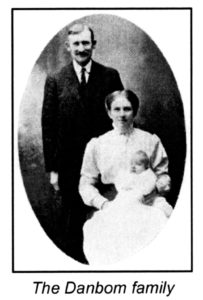 Immigrant recruiter buried in Stanton, Iowa
Immigrant recruiter buried in Stanton, Iowa
Other Swedes on board Titanic did not have the opportunity to live a long, full life. On pages 231-233 of Not My Time to Die, Setterdahl relates the sad fate of Ernest Danbom, a 34-year-old farmer and immigrant recruiter who was born and raised in Montgomery County, Iowa.
The son of two Swedish immigrants who farmed in southwest Iowa, Danbom married his wife, Anna, in 1910. The newlyweds traveled to Sweden for their honeymoon and remained with Anna’s family for a number of months. During this time, Anna gave birth to the couple’s son, Gilbert, in Kisa, Sweden, on November 16, 1911.
By April 1912, the young family prepared to return to America. Danbom also assumed the role of tour conductor for a group of 11 Swedes (including Anna Nysten and the Andersson family) who were traveling on Titanic.
As an immigrant recruiter, Danbom received a commission from each person he encouraged to come to America. Even after paying approximately $68 for a family cabin on Titanic, Danbom was carrying a substantial amount of money (including $276 in cash and $30 in gold) when he left Sweden, according to Not My Time to Die. He hoped that the money would help his family acquire a fruit farm in Turlock, California.
Tragically, none of the young family would survive the sinking of Titanic. Danbom’s wife and young son were lost at sea. Danbom’s body was recovered and brought to Halifax in Canada before being sent to Stanton, Iowa, for burial.
The Halifax coroner listed among his personal effects a black overcoat, dark suit, white pleated shirt, black boots, wedding ring marked “S.B.T.E.G.D., June 6, ’10,” gold watch and chain, knife, keys, opal and ruby ring, fountain pen, bracelet, ladies watch and chain, 3 memo books, solitaire diamond ring, scissors, U.S. naturalization papers, pocketbook, jewel case, and a check for $1,315.79, Security Bank, Sioux City.
Danbom is buried in the cemetery in Stanton. The inscription on his tombstone reads, “Ernest Danbom, 26 Oct 1877, died 15 April 1912, in Titanic disaster, his remains were recovered from the ocean. “Nearer My God to Thee.”
“No, I must be a gentleman”
In Cedar Rapids, attention focused on the well-known Douglas family, who endured an excruciating wait to learn the fate of Walter Douglas, 50, and his second wife, Mahala, first-class passengers on Titanic.
Walter Douglas was son of the founding partner of The Quaker Oats Company in Cedar Rapids. In 1903, Douglas and his brother George, founded the Douglas Starch Works, which produced cooking starch and oil, laundry starch, animal feed, soap stock and industrial starches.
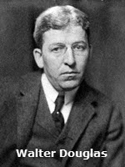 After celebrating Christmas 1911 with the Douglas family at the Brucemore mansion in Cedar Rapids, Walter and Mahala traveled to Europe for a three-month vacation to celebrate Walter’s retirement, according to Brucemore historic site and community cultural center, which has preserved this history. While in Europe, the couple also purchased furnishings for their mansion on a bluff overlooking Lake Minnetonka near Minneapolis, Minnesota.
After celebrating Christmas 1911 with the Douglas family at the Brucemore mansion in Cedar Rapids, Walter and Mahala traveled to Europe for a three-month vacation to celebrate Walter’s retirement, according to Brucemore historic site and community cultural center, which has preserved this history. While in Europe, the couple also purchased furnishings for their mansion on a bluff overlooking Lake Minnetonka near Minneapolis, Minnesota.
The couple bought first-class tickets for themselves and their French maid, Berthe Leroy, to return home aboard Titanic in time to celebrate Walter’s birthday on April 21 with family. First-class tickets on Titanic ranged from roughly $150 for a simple berth–about $3,600 today, based on current inflation tables, to $4,350 (more than $100,000) for one of the two Parlour suites.
On the night Titanic struck the iceberg, Walter and Mahala had just returned to their suite from the first-class dining room when they heard the engines stop. After Mahala asked Walter to find out what was going on, she donned her fur coat and boots to wait in the hallway. Seeing no officers and receiving no orders, Mahala grew concerned and returned to her cabin for a life preserver. Walter returned and teased her about the preserver, but agreed they should go on deck together. The couple watched as the distress rockets shot high into the air and burst into a shower of light.
Passengers on deck remained calm as they boarded the lifeboats. As Mahala climbed into a lifeboat, she requested that Walter join her. “No, I must be a gentleman,” he said before joining a group of men waiting for another lifeboat. Dressed in his tuxedo, Walter was last seen helping women and children into the final lifeboats.
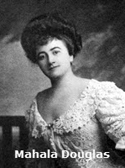 After Titanic sank, initial reports of the disaster were sparse and contradictory. The limits of wireless communication and the isolation of the disaster limited accurate information. When news of the tragedy reached Cedar Rapids, the magnitude of the disaster and the fate of Walter and Mahala were unknown.
After Titanic sank, initial reports of the disaster were sparse and contradictory. The limits of wireless communication and the isolation of the disaster limited accurate information. When news of the tragedy reached Cedar Rapids, the magnitude of the disaster and the fate of Walter and Mahala were unknown.
“The news of Titanic’s disaster came at noon while we were at luncheon,” noted an April 15 diary entry written by Irene Douglas, Walter’s sister-in-law who lived at Brucemore. “Did not seem serious until evening about 7:30 – spent the evening at the [Cedar Rapids] Republican [newspaper] office.”
Hearing no news, Irene and her husband, George, left Cedar Rapids on April 16 to meet the Carpathia, which was carrying Titanic survivors to New York. On April 17, the Cedar Rapids Evening Gazette reported:
“Up to 1 o’clock today no definite news had been received in Cedar Rapids concerning the fate of Mr. Walter D. Douglas…. The wireless telegraph companies having great trouble in effecting communication with the Carpathia…. It appears that a considerable number of the first and second cabin passengers, especially the men, must have perished, but it is still hoped that Mr. Douglas was among the ones rescued. Mrs. Douglas is on the Carpathia, but whether Mr. Douglas went down with the boat, as did many others of the male passengers, remains to be determined.”
On April 18, thousands of people waited in the rain in New York as the ship bearing approximately 700 Titanic survivors slowly approached the dock.
“Carpathia landed 7 in the eve.,” Irene noted in her diary. “Walter not with Mahala.”
Eight days after the sinking, the Douglas family received word on April 23 that Walter’s body had been recovered by the cable ship MacKay Bennett, the same ship that recovered the body of Wallace Hartley, whose seven-member band played as Titanic sank.
The Mackay-Bennett recovered 306 bodies near the scene of the sinking, including the body of Walt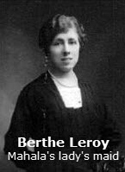 er Douglas, who was identified by his monogrammed shirt and cigarette case. The ship’s crew recorded the following information:
er Douglas, who was identified by his monogrammed shirt and cigarette case. The ship’s crew recorded the following information:
• No. 62 – MALE – Estimated age, 55 – Hair grey
• Clothing – Evening dress, with “W.D.D.” on shirt.
• Effects – Gold watch; chain; gold cigarette case “W.D.D.”; five gold studs; wedding ring on finger engraved “May 19th ’84”; pocket letter case with $551
(Interesting side note: The Mackay-Bennett was at sea working on a French trans-Atlantic cable when it got the charter from Titanic’s owners, White Star Line, to join the recovery efforts. After returning to Halifax, Nova Scotia, in Canada to pick up a hold full of ice to refrigerate bodies, 100 coffins, canvas sacks, an undertaker, and embalming fluids and equipment, the Mackay-Bennett headed out to sea to search for Titanic victims in a mission continually hampered by fog, heavy waves and wind. With its supply of coffins quickly filled and a steady stream of bodies being brought aboard by crewmen who went out in lifeboats, the Mackay-Bennett had to borrow canvas sacks and more embalming supplies from other recovery ships. The Mackay-Bennett buried at sea 116 of the 306 bodies it recovered, likely because they were not in good enough shape to be taken to Halifax. The ship took 190 victims to Halifax, where unclaimed bodies were buried in various cemeteries.)
Walter Douglas’ remains were taken first to his home in Minneapolis, then via a special train to Cedar Rapids for entombment in the Douglas family vault at Oak Hill Cemetery.
Mahala returned to her home on Lake Minnetonka, accompanied only by her maid, Berthe Leroy. An advocate of arts and culture, Mahala supported many local charities and made a donation in Walter’s name to Coe College in Cedar Rapids. A talented writer, Mahala published a collection of stories and poems in 1932. One copy, inscribed to George and Irene Douglas, is stored in the Brucemore archives. The last poem in the book is a haunting account of Titanic’s demise.
Titanic
The sea velvet smooth, blue-black,
The sky set thick with stars unbelievably brilliant.
The horizon a clean-cut circle.
The air motionless, cold – cold as death.
Boundless space.
A small boat waiting, waiting in this vast stillness,
Waiting heart-breakingly.
In the offing a vast ship, light streaming from her portholes.
Her prow on an incline.
Darkness comes to her suddenly.
The huge black hulk stands out in silhouette against the star-lit sky.
Silently the prow sinks deeper,
As if some Titan’s hand,
Inexorable as Fate,
Were drawing the great ship down to her death.
Slowly, slowly, with hardly a ripple
Of that velvet sea,
She sinks out of sight.
Then that vast emptiness
Was suddenly rent
With a terrifying sound.
It rose like a column of heavy smoke.
It was so strong, so imploring, so insistent
One thought it would even reach
The throne of grace on high.
Slowly it lost its force,
Thinned to a tiny wisp of sound,
Then to a pitiful whisper….
Silence.
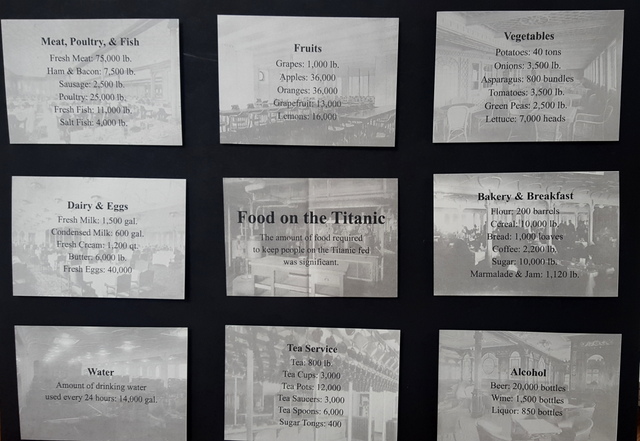 Food for thought as Titanic’s legacy lives on
Food for thought as Titanic’s legacy lives on
While more than 100 years have passed since Titanic plunged to the bottom of the sea, interest in the magnificent ship never wanes. In fact, Titanic II, a faithful replica of the doomed ship, is preparing for passengers by 2018.
The brainchild of Australian billionaire Clive Palmer, Titanic II will have practically the same dimensions of the original Titanic, which would be on the smaller side of modern cruise ships. (Shrewdly, the Titanic II will have more lifeboat capacity than the original ship.)
When Titanic II makes its maiden voyage from Jiangsu, China, to Dubai, no doubt it will offer exceptional meals, just as its predecessor did. The original Titanic’s provisions included 75,000 pounds of fresh meat, 11,000 pounds of fresh fish, 4,000 pounds of salted and dried fish, 7,500 pounds of bacon and ham, 40,000 fresh eggs, 40 tons of potatoes, 2,200 pounds of coffee, 10,000 pounds of sugar and 250 barrels of flour.
When I sampled an unforgettable taste of Titanic in Iowa City during the Johnson County Historical Society’s “Afternoon Tea on the Titanic,” one of my favorite menu items was the Victoria Sponge Cake.
“This cake is everyone’s favorite,” declares Penelope Carlevato in her book Tea on the Titanic: 100 Years Later. “No leftovers when you serve this cake.” I can see why, especially with this cake’s light texture and sweet filling that’s perfect with homemade jam (my favorite) or your best store-brought preserves.
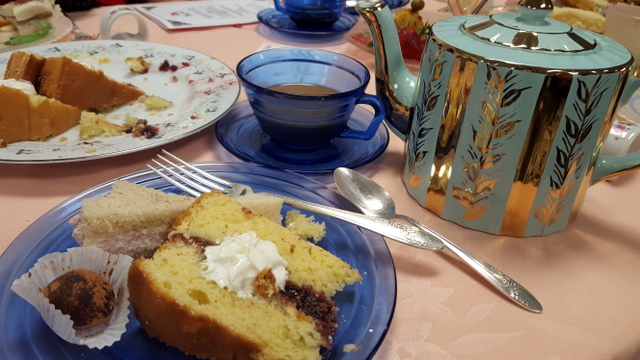
Victoria Sponge Cake served at the Johnson County Historical Society’s “Afternoon Tea on the Titanic” in Iowa City on April 2, 2017
Victoria Sponge Cake
Cake:
1 cup unsalted butter (at room temperature)
1 cup granulated sugar
4 eggs, beaten
2 cups self-rising flour, sifted flour
Filling:
1 cup jam, preserves or lemon curd (or whipping cream, if you desire)
Powdered sugar
Cream butter and sugar until light and fluffy. Add eggs and mix well. Grease and line two 8-inch round cake pans with parchment paper. Divide batter between the pans and smooth the tops for evenness.
Bake 20 to 25 minutes at 375 degrees Fahrenheit. Cool for 10 to 15 minutes in pans; then turn cakes out onto wire racks to continue cooling.
Place a paper doily on a footed cake plate. Sandwich bottoms of cake together with jam or preserves (strawberry preserves, raspberry preserves or apricot jam work well). Whipping cream could be substituted for the jam, if desired. Sprinkle top of cake with powdered sugar.
Decorate cake plate with chemical-free flowers such as violets or nasturtiums, if desired. (Wash the flowers well before use.)
Want more Iowa culture and history?
Read more of my blog posts if you want more Iowa stories, history and recipes, as well as tips to make you a better communicator.
If you’re hungry for more stories of Iowa history, check out my top-selling “Culinary History of Iowa: Sweet Corn, Pork Tenderloins, Maid-Rites and More” book from The History Press, as well as my Calhoun County” book from Arcadia Publishing, which showcases the history of small-town and rural Iowa. Order your signed copies today! Iowa postcards are available in my online store, too. Coming soon in September 2017–my third Iowa history book! Watch for more details on “Dallas County” from Arcadia Publishing.
P.S. Thanks for joining me. I’m glad you’re here.
@Copyright 2017 Darcy Maulsby & Co.
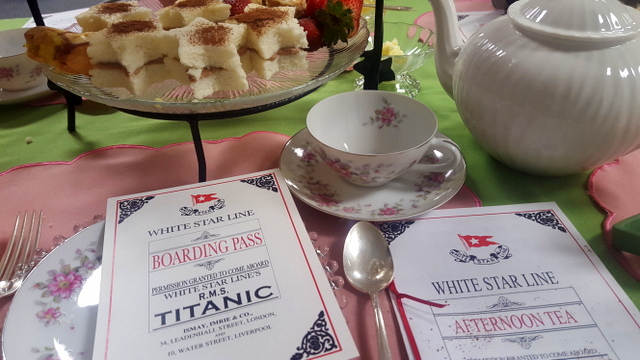

Leftover Ham? Make This Amazing Crustless Spinach and Ham Quiche
A ham for Easter dinner has been a tradition in my family for as long as I can remember. It’s no wonder, since I grew up on a farrow-to-finish hog farm in Calhoun County, Iowa. Ever wonder why ham became an Easter tradition?
In the days before refrigeration, hogs were harvested in the fall. The hams were preserved by curing (salting and/or smoking). This process took a long time, and the first hams were ready to eat in the spring. Ham, then, was a natural choice for the Easter celebration.
The National Pork Board recently conducted a Ham Research Study (wouldn’t you love that job?) and found that that 69 percent of Americans served ham for Easter dinner in 2016. Also, 55 percent of consumers enjoy ham as an everyday meal. I’m certainly one of them.
If you have leftover ham this Easter, why not power up your next meal with my Crustless Quiche? This recipe is incredibly simple, flavorful and packed with veggies and protein. What more could you ask for?
Crustless Spinach and Ham Quiche
1 tablespoon olive oil
1 cup chopped onion
1 cup sliced fresh mushrooms (or 2 cans sliced mushrooms)
Diced red and orange peppers, if desired
1 package (10 ounces) frozen chopped spinach, thawed and drained
1 cup chopped, fully cooked ham
5 large eggs
3 cups shredded Cheddar or Monterey Jack cheese
1/8 teaspoon fresh-ground pepper
In a large skillet, saute onion and mushrooms in oil until tender. Add spinach and ham; cook and stir until the excess moisture is evaporated. Cool slightly. Beat eggs; add cheese and mix well. Stir in spinach mixture and pepper; blend well. Spread evenly into a greased 9-in. pie plate or quiche dish. Bake at 350° for 40-45 minutes or until a knife inserted in center comes out clean. Yield: 8 servings. Enjoy!
Want more Iowa culture and history?
Read more of my blog posts if you want more Iowa stories, history and recipes, as well as tips to make you a better communicator.
If you’re hungry for more stories of Iowa history, check out my top-selling “Culinary History of Iowa: Sweet Corn, Pork Tenderloins, Maid-Rites and More” book from The History Press, as well as my Calhoun County” book from Arcadia Publishing, which showcases the history of small-town and rural Iowa. Order your signed copies today! Iowa postcards are available in my online store, too.
P.S. Thanks for joining me. I’m glad you’re here.
@Copyright 2017 Darcy Maulsby & Co.
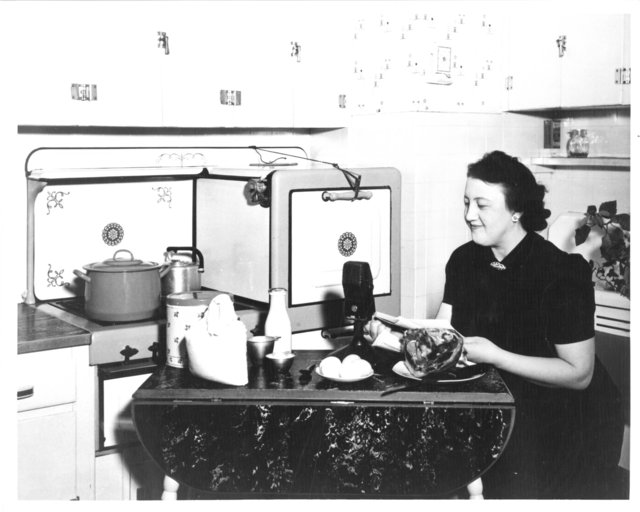
Cooking with Iowa’s Radio Homemakers
Long before there was Martha Stewart, there were KMA’s radio homemakers. These creative, talented ladies from southwest Iowa revolutionized women’s roles far beyond their humble farm kitchens starting in the 1920s. As they delighted Midwestern audiences by sharing their favorite recipes and providing down-home, daily visits with their radio friends, some of the women also became successful entrepreneurs along the way.
Their story begins in the early 1920s with the debut of a fabulous new invention called radio. In 1925, when a local businessman named Earl May began broadcasting KMA Radio-960 from Shenandoah, Iowa, to promote his seed and garden business. The station gained a following by airing practical information designed to help with the day-to-day life in Midwestern farm kitchens.
Before long, KMA was a trusted friend throughout the wide listening area, offering inspiration, companionship, and all manners of domestic counsel. The power of this connection can’t be understated when you consider the era—a time when farm wives were much more isolated than today due to poor roads, limited social opportunities and long days filled with endless chores.
A roster of personable, lively women who quickly became known as the KMA Radio Homemakers hosted KMA’s daily radio programs, including the Home Hour, the Stitch and Chat Club, and the KMA Party Line, while live cooking demonstrations drew thousands to the KMA auditorium in Shenandoah.
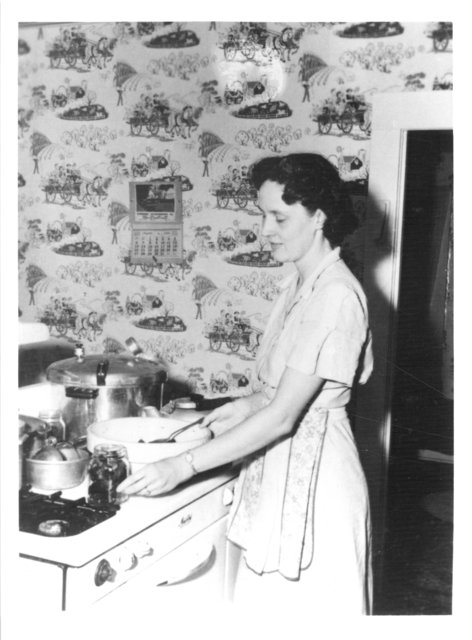
Evelyn Birkby was one of the beloved radio homemakers from southwest Iowa.
Broadcasts reached across the Midwest
The radio homemakers’ history is also linked to Earl May’s local competitor, Henry Field, another nursery and garden entrepreneur who seized on the power of radio to help expand his business. Field recruited family members to go on the air, including his sister, Leanna Field Driftmier, who began broadcasting “The Mother’s Hour,” which became “Kitchen Klatter.” Without any training, Leanna sat down at the microphone and just started talking about her home, family, recipes, household tips, advice for child- rearing and whatever news seemed worth sharing during the afternoon show.
In 1930, Leanna broke her back in a car accident but wanted to continue her show, despite her injuries. The radio equipment was brought to her home, and she broadcast from her bed and later from her kitchen table. The show became so popular amongst listeners that it was eventually was broadcast in six Midwestern states.
Neighboring on the air
As the radio homemakers’ concept gained momentum, local farm women like Evelyn Birkby began broadcasting from their kitchens in the 1950s. In her show “Down a Country Lane” on KMA Radio, Birkby would discuss her family and share snippets from her daily life, as well as offer suggestions for making the home a more pleasant place to live. Birkby called this phenomenon “neighboring on the air,” and it met a vital need when farm life could often be isolating.
Fans would follow the doings of favorite homemakers for years, tuning in each day the same way they’d listen to episodes of radio soap operas. Of course, recipes figured prominently in the broadcasts, with old-fashioned, Midwestern fare focused on meat and potatoes, hearty casseroles, cakes, pies, cookies and more.
Kitchen Klatter became home-grown success
Through the years, a line of Kitchen Klatter products (including food flavorings, bleach and more) was developed and sold over the radio by broadcasters like Leanna Driftmier. In addition, a monthly Kitchen Klatter magazine was circulated to thousands of Midwestern readers who enjoyed the articles, letters and recipes like Company Ham and Potatoes, Emerald Mint Sauce (made from Kitchen Klatter Mint Flavoring), Mary’s Pineapple Pie and Grandma’s Oatmeal Cookies. The Kitchen Klatter enterprise and the radio homemakers endured for a number of years, with some of the broadcasts lasting until the 1990s.
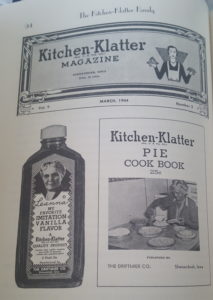 Recipes preserve a taste of Iowa history
Recipes preserve a taste of Iowa history
In 1991, Evelyn Birkby published the fascinating book “Neighboring on the Air,” where you can almost hear the voices of the KMA homemakers while you get a taste of their philosophy of life and sample their recipes. You can learn how to make hearty Midwestern fare ranging from Sour Cream Apple Pie from Florence Falk, “The Farmer’s Wife,” to Six-Layer Washday Dinner from Doris Murphy, who took to the air in 1949 with her “Party Line” broadcast.
You’ll get a sense what a grueling schedule the radio homemakers often endured as they broadcast radio shows out of their kitchen while their own family life went on about them. These ladies also knew the needs and interests of their audience, because they, too, were well acquainted with hard work, hard times and making do.
Through it all, the radio homemakers were Martha Stewart and Dear Abby all rolled into one as they shared news about their children, home beautification tips and their trusted recipes. Thousands of devoted listeners depended on them for weekly entertainment, information, humor and continuity. These listeners considered the radio homemakers a valued part of their lives, which is reflected in the longevity of the radio shows. The radio homemakers’ remarkable contributions are an enduring legacy to power of Iowa farm women and add unforgettable flavor to Iowa’s rich culinary heritage.
Six-Layer Washday Dinner
Like today’s busy working women, Iowa’s radio homemakers like Doris Murphy knew the value of being able to put a hearty, nutritious meal on the table without a lot of fuss. No doubt her recipe featured home-grown and home-canned vegetables.
2 cups hamburger
1 small onion, chopped
2 cups diced potatoes, raw
½ cup uncooked rice
1 cup sweet peppers, cut fine
1 cup diced carrots, raw
1 pint tomatoes
Brown hamburger and onion together. Combine meat, onion, potatoes, rice, peppers, carrots and tomatoes. Season with salt and pepper. Cover with water. Cook 2 hours in 350-degree oven.
Want more Iowa culture and history?
Read more of my blog posts if you want more Iowa stories, history and recipes, as well as tips to make you a better communicator.
If you’re hungry for more stories of Iowa history, check out my top-selling “Culinary History of Iowa: Sweet Corn, Pork Tenderloins, Maid-Rites and More” book from The History Press, as well as my Calhoun County” book from Arcadia Publishing, which showcases the history of small-town and rural Iowa. Order your signed copies today! Iowa postcards are available in my online store, too.
P.S. Thanks for joining me. I’m glad you’re here.
@Copyright 2017 Darcy Maulsby & Co.

Celebrating Pi Day in Iowa with Old-Fashioned Chicken Pot Pie
As a food writer, here’s my foolproof equation: Pi Day (3/14) + old-fashioned chicken pot pie = true Iowa comfort food. Foodies like me aren’t nearly as concerned about the ratio of the circumference of a circle to its diameter (which is approximately 3.14159), UNLESS that pie is either a sweet or savory creation. Check out my recipe for Old-Fashioned Chicken Pot Pie (it’s what’s on the menu for lunch at the farm today!), including a recipe for the easiest—and tastiest—homemade pie crust.
I tip my hat to my friend Marlene (Lasher) Glasnapp of Lytton, Iowa, for the fantastic, lard-based pie crust recipe I’ve included below the pot-pie recipe. When you compare notes with an experienced farm cook like Marlene, don’t be surprised if you find new ways to break the “rules” of pie baking outlined in the cookbooks.
“I don’t use ice water when I make my pie crusts, and I prefer old-fashioned enameled pie tins to other types of pie dishes,” says Marelene, who grew up on a farm near Lake City and lives with her husband, Roger, on their farm south of Lytton. “Basically, I try to keep things as simple as possible.”
That includes sticking with tried-and-true favorites, such as her mother’s flavorful lard pie crust recipe, which Marlene has relied on for more than 60 years. I love this pie crust for three big reasons, including 1) it’s so easy, 2) it tastes great, and 3) lard-based crusts are one of the most forgiving, easy-to-work with pie pastries I’ve encountered.
Enough talk–let’s cook!
Old-Fashioned Chicken Pot Pie
This recipe is hearty, filling and makes enough for two 9-inch pot pies. If you’re not feeding a crowd, this freezes well.
2 cups diced potatoes
2 cups sliced carrots
1 cup butter
1 cup chopped onion
1 cup all-purpose flour
2 teaspoons salt
1 teaspoon dried thyme
3/4 teaspoon pepper
3 to 4 cups chicken broth
1-1/2 cups milk
4 cups cubed cooked chicken
1 cup frozen green beans
1 cup whole-kernel corn
Pie crust (either 2 packages of refrigerated pie pastry or homemade pie crust—see recipe below)
Preheat oven to 425 degrees Fahrenheit. Place potatoes and carrots in a large saucepan; add water to cover. Bring to a boil. Reduce heat; cook, covered, 8-10 minutes or until crisp-tender; drain. (I save the vegetable broth for future cooking adventures.)
In a large skillet, heat butter over medium-high heat. Add onion; cook and stir until tender. Stir in flour and seasonings until blended. Gradually stir in broth and milk. Bring to a boil, stirring constantly; cook and stir 2 minutes or until thickened. Stir in chicken, green beans, corn and potato mixture; remove from heat.
Roll out your homemade pie crust, and cut the dough into a circle big enough to cover your pie plate. OR, unroll a pre-made pastry sheet into each of two 9-in. pie plates; trim even with rims. Add chicken mixture. Unroll remaining pastry; place over filling. Trim, seal and flute edges. Cut slits in tops.
Bake 35-40 minutes or until crust is lightly browned. Let stand 15 minutes before cutting.
Freeze option: Cover and freeze unbaked pies. To use, remove from freezer 30 minutes before baking (do not thaw). Preheat oven to 425°. Place pies on baking sheets; cover edges loosely with foil. Bake 30 minutes. Reduce oven setting to 350°; bake 70-80 minutes longer or until crust is golden brown and a thermometer inserted in center reads 165°. Yield: 2 potpies (8 servings each).
World’s Best Pie Crust
For more than 60 years, my friend Marlene Glasnapp has relied on this classic Iowa recipe, which yields up to 6 crusts per batch.
5 cups flour
1 teaspoon salt
1 pound lard
1 cup water
Combine flour and salt. Cut lard into the flour mixture. Add water, a little at a time, mixing quickly and evenly until dough just holds together in a ball. Divide dough for six crusts. (The crusts can be frozen for later use, and Marlene often rolls hers out before freezing.)


